Key takeaways
- Understanding a subject’s personality is essential for effective portrait styling, impacting wardrobe choices and overall presentation.
- Lighting plays a crucial role in shaping the mood of a portrait, with soft diffused light conveying gentleness and harsher light adding drama.
- Subtle posing techniques and eye contact significantly enhance the emotional connection and energy of the portrait.
- Editing should enhance natural features without overdoing it, maintaining the portrait’s authenticity while adding a creative touch.
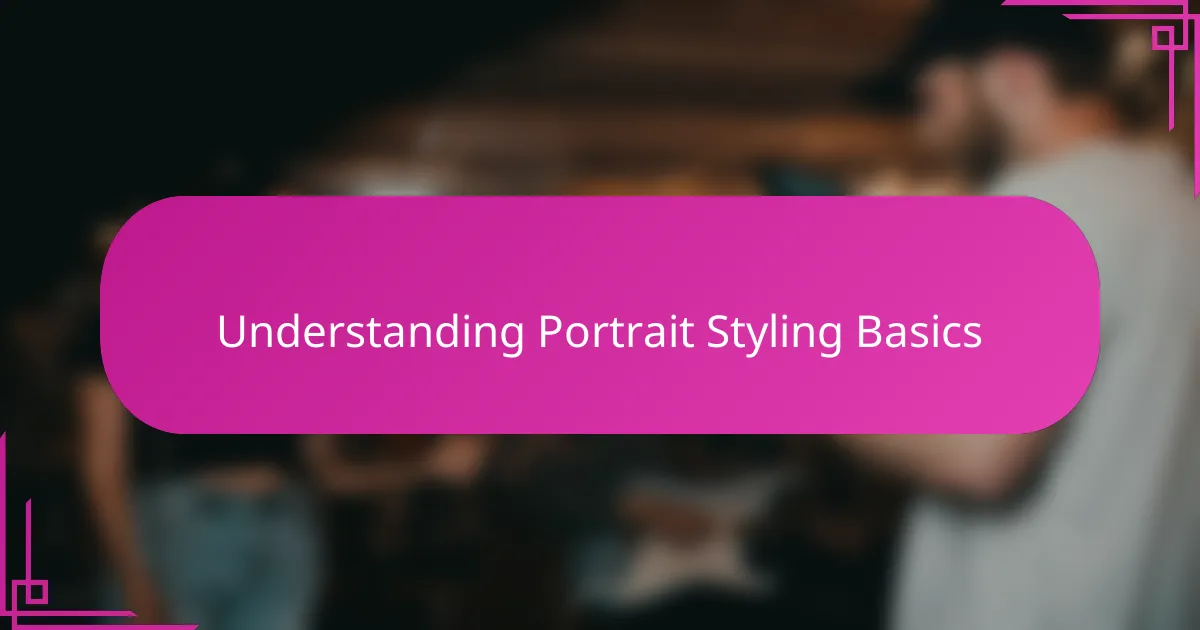
Understanding Portrait Styling Basics
Styling a portrait isn’t just about picking clothes; it’s about capturing the essence of the person in front of the lens. I’ve found that understanding the subject’s personality first helps me choose elements that truly reflect who they are, rather than just what looks good on camera. Have you ever noticed how a single accessory can suddenly bring out someone’s confidence? I always look for those subtle details.
Color plays a huge role in portrait styling, and it’s something I’ve experimented with extensively. Warm tones can evoke intimacy, while cooler colors often create a calm, distant mood. Sometimes, I deliberately challenge traditional color choices to provoke a more emotional response—because styling is storytelling, and every color tells a chapter.
Texture and fabric also deserve attention. Smooth silk or soft cotton can change the way light interacts with the subject, adding depth to the image in unexpected ways. From my experience, blending textures thoughtfully often transforms a simple portrait into something with layers of visual interest, making the viewer want to look closer. Isn’t that the goal after all?
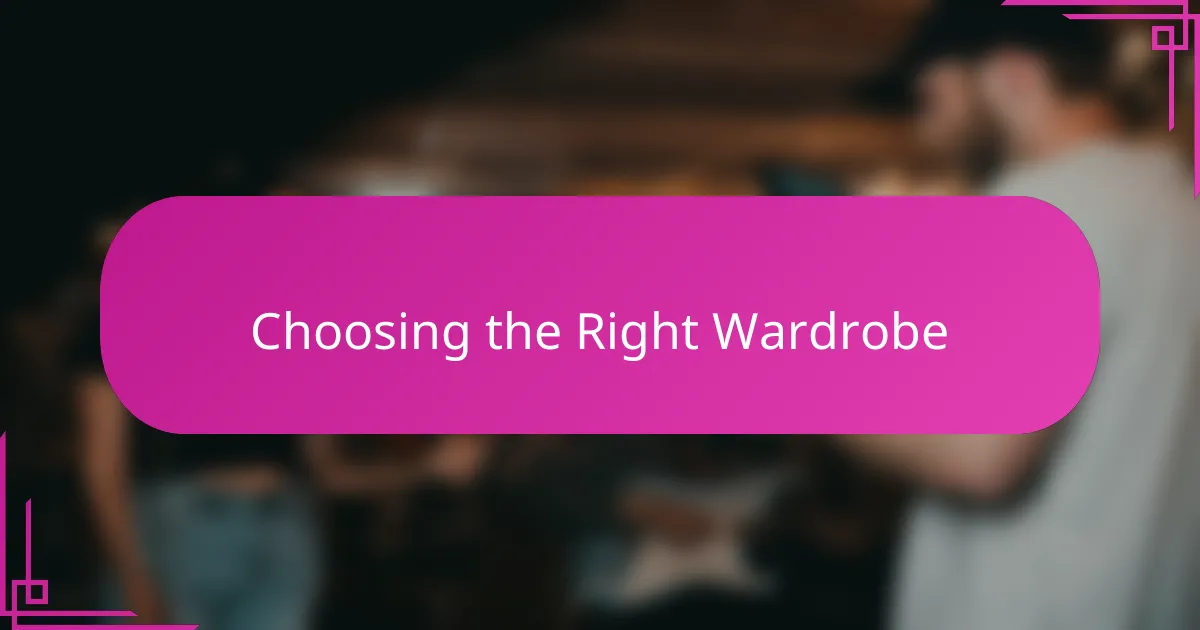
Choosing the Right Wardrobe
Choosing the right wardrobe is like setting the stage before the performance begins. I remember once working with a subject whose vibrant personality was perfectly echoed by a mix of bold patterns and rich textures—something I wouldn’t have dared to try if I’d stuck to safe, neutral tones. Don’t you think clothing should feel like an extension of who someone really is, rather than just an outfit?
I often ask myself how different fabrics will behave under the lighting I plan to use. For example, a matte cotton shirt absorbs light and gives a soft, approachable feel, while something glossy can add a dramatic shine that changes the entire mood of the portrait. Paying attention to these details has saved me from countless last-minute wardrobe disasters.
Then there’s the emotional connection wardrobe creates. When someone wears clothes that make them feel confident, it shows in their eyes and posture. I always encourage my clients to bring pieces that tell their story. After all, isn’t the best portrait one where the person’s true self shines through?

Selecting Ideal Lighting Setup
Lighting can make or break a portrait, and I’ve learned that selecting the ideal setup starts with understanding the mood I want to convey. Soft, diffused light often brings out a subject’s gentleness, while harsher shadows can add drama or mystery. Have you ever noticed how the same face looks completely different simply because of the direction and intensity of light?
In one shoot, I experimented with natural window light pouring in from the side, and it transformed the whole feel of the images—bringing out textures in skin and fabric that I hadn’t anticipated. It made me realize that sometimes the simplest setups create the most authentic portraits. Don’t you think that lighting should almost feel like a dance partner, moving in sync with the subject to tell their story?
I also pay close attention to how lighting interacts with the colors and textures we’ve chosen for wardrobe and props. Glossy fabrics can reflect light in unexpected ways, while matte surfaces absorb it, altering the portrait’s tone. From experience, combining these elements thoughtfully can turn a technically good shot into something truly captivating. What lighting moment have you found most surprising in your portrait work?
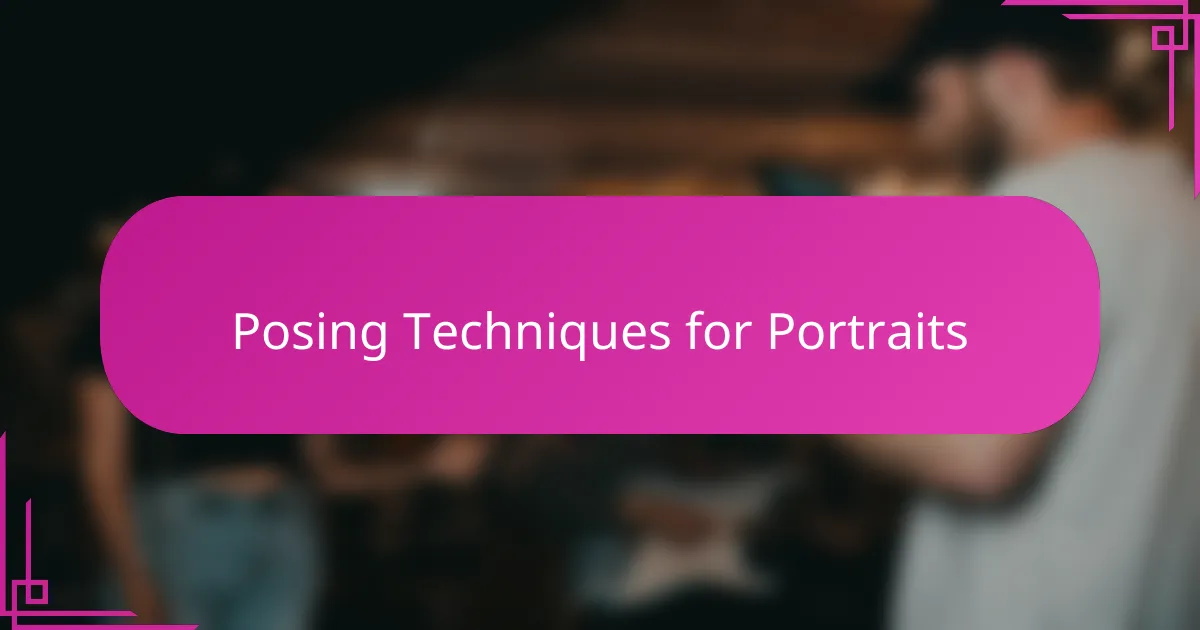
Posing Techniques for Portraits
Posing is where the magic really begins for me—it’s not just about standing still but creating a natural, relaxed vibe that lets the subject’s personality shine through. I often encourage subtle movements, like a slight tilt of the head or shifting weight to one leg, because those tiny changes can make a portrait feel alive rather than stiff. Have you ever noticed how just a small adjustment in posture can completely change the energy of a photo?
Eye contact is another powerful tool in posing. Sometimes, I ask my subjects to look away contemplatively, which adds a layer of mystery, while other times, direct gaze can create an intimate connection with the viewer. One memorable session involved a shy client who opened up beautifully once I shifted their pose and gently guided their gaze—it reminded me how much posing is also about building trust and comfort.
Hands are often overlooked in portraits, but I’ve learned they can say so much without words. Whether resting softly on the face or loosely by the side, their placement influences the story the portrait tells. I like to experiment with different hand poses that feel natural for each person, because awkward hands can pull the viewer out of the moment just as easily as awkward smiles. Have you found your own go-to hand poses that just click every time?
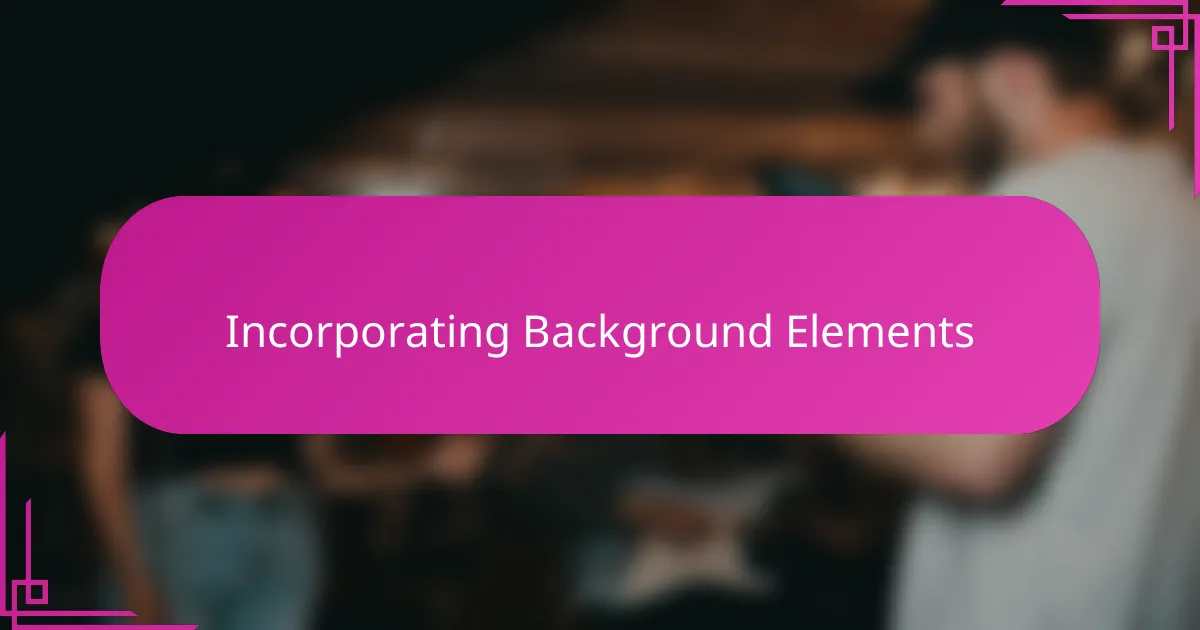
Incorporating Background Elements
Background elements often do more than just fill space behind the subject; they add context and depth to the story I’m trying to tell with each portrait. I remember a shoot where a weathered wooden door in the background echoed the subject’s rugged character perfectly—without saying a word, the environment spoke volumes. Do you find that certain backgrounds can sometimes become characters themselves in your images?
Incorporating textures and colors from the background can either complement or contrast with the subject’s wardrobe, which I’ve found is a subtle way to guide the viewer’s emotions. For instance, pairing a smooth silk blouse with a rough brick wall felt like mixing softness and strength in one frame. Have you ever played with opposing textures in background and wardrobe to create a visual tug-of-war that keeps the viewer intrigued?
Sometimes, I like to use minimalistic backgrounds to keep the focus sharp on the subject’s expressions and styling details. But other times, layering background elements thoughtfully—like plants, furniture, or architectural lines—adds layers of meaning that mere portraits often lack. What’s your take on balancing simplicity and detail when bringing backgrounds into the portrait frame?
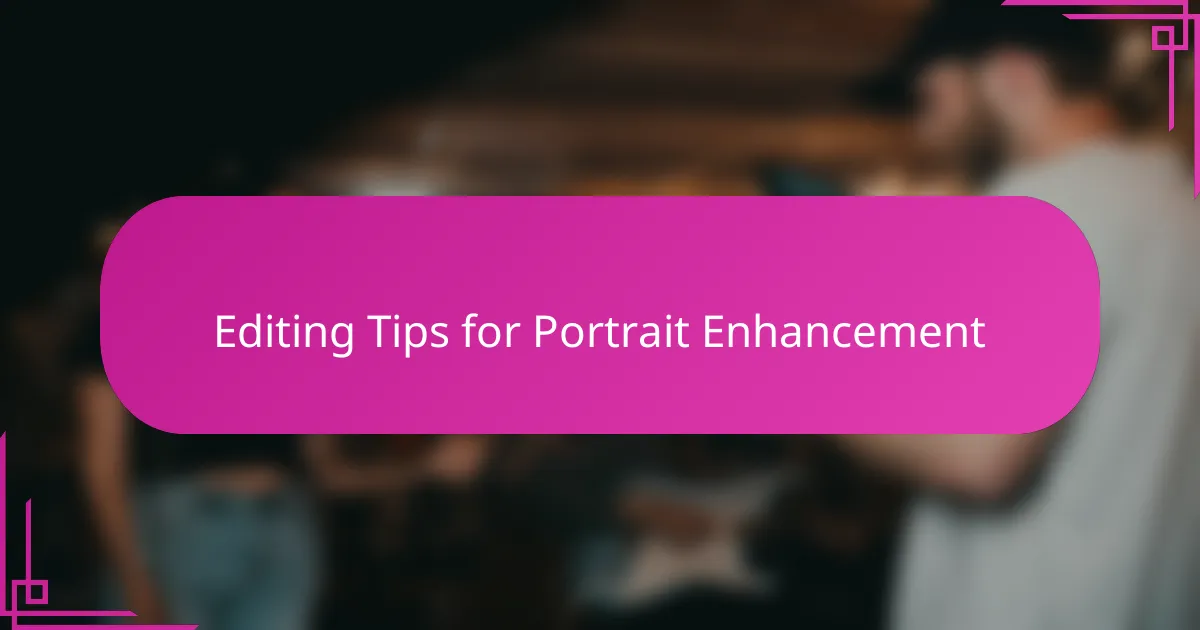
Editing Tips for Portrait Enhancement
When I sit down to edit portraits, one of my first moves is to gently smooth the skin without erasing those natural textures that make a face unique. I’ve noticed that over-editing can rob a portrait of its soul, so I’m usually very careful to enhance rather than erase. Have you ever struggled to find that delicate balance between polished and real?
Adjusting the lighting during post-processing is another step I often find myself revisiting. Sometimes increasing contrast just a touch or boosting the highlights on the eyes can bring a portrait to life in a way the original shot didn’t quite capture. It’s like adding a little spark that draws the viewer deeper into the image. Doesn’t that subtle glow make all the difference?
Color grading is another powerful tool in my editing kit. I often experiment with warming or cooling tones depending on the mood I want to evoke, recalling how certain color palettes helped shape the story during the shoot. Have you noticed how a simple tweak in hue can shift the entire emotional tone of a portrait? That’s where editing moves from technical work to creative storytelling for me.
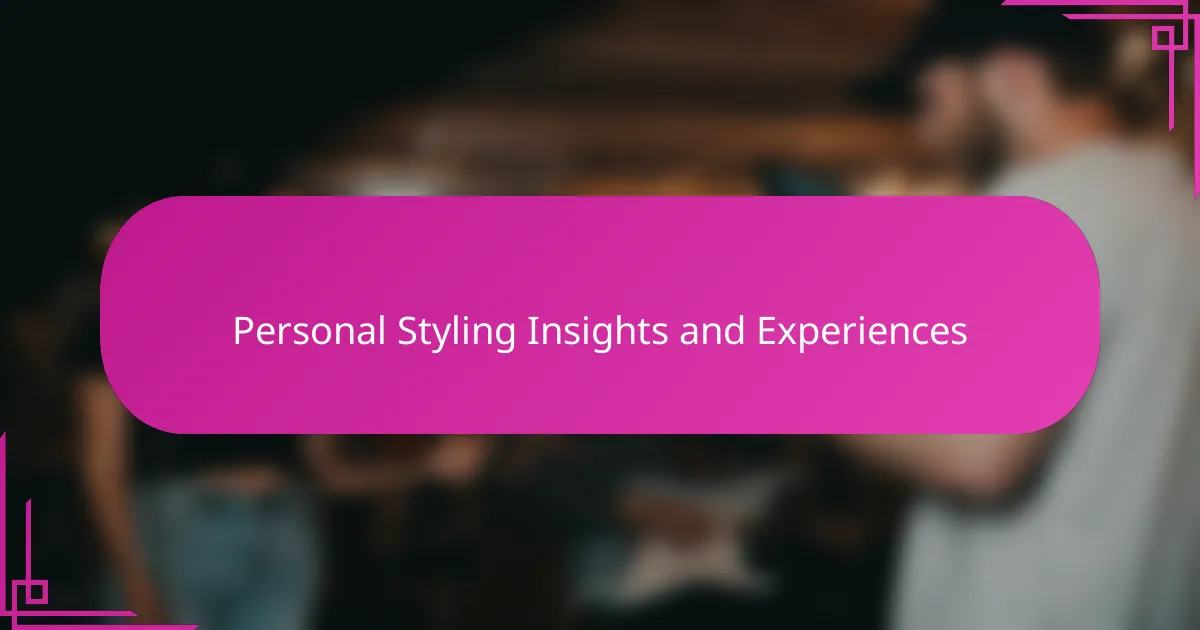
Personal Styling Insights and Experiences
Styling portraits has always felt like a personal journey to me—one where I’m constantly learning how clothing choices reveal hidden layers of my subjects’ stories. I recall a session where my client hesitated over a bold jacket, but once she wore it, her energy shifted completely, and the camera caught that newfound confidence effortlessly. Have you ever witnessed how a simple style decision can unlock a side of someone you didn’t expect?
Over time, I’ve realized that personal styling isn’t just about aesthetics; it’s about empathy and connection. I invest time in conversations to understand what makes someone feel authentic and comfortable, because only then does their true self shine through the lens. Doesn’t it feel rewarding when styling becomes a collaborative experience rather than a one-sided decision?
I also like to experiment with mixing classic and unconventional elements, which often leads to unexpected yet captivating portraits. For instance, pairing vintage accessories with modern outfits once sparked a narrative about timelessness and individuality that felt deeply personal. What styling risks have you taken that turned out to be game-changers in your portrait work?